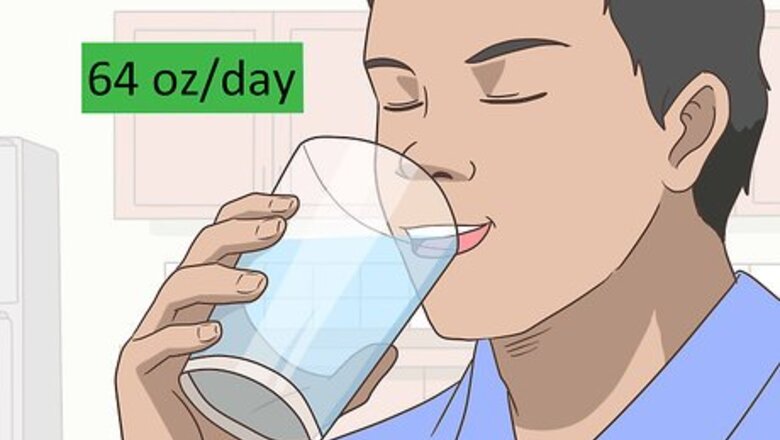
views
X
Research source
Ensuring You Consume and Retain Plenty of Fluids
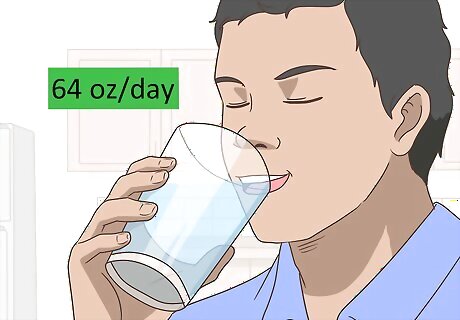
Consume plenty of fluids. Quick thirst fixes aside, ultimately your first line of defense against feeling thirsty is to maintain normal fluid levels in your body, or by staying well-hydrated. One of the best ways to do this is by consuming at least 64 ounces of fluids per day. You should consume more if you feel excessively thirsty or if your urine is a dark yellow in color. You can get these fluids by drinking eight glasses containing eight ounces of water each. You may also be able to get fluids from food. Milk and juice for instance, are comprised mostly of water. Coffee, tea and soda also have water but also contain caffeine, which is a mild diuretic and increases fluid loss. If you exercise a lot, though, you need to increase your fluid intake largely due to sweating, which is the body’s way of cooling itself. Before exercising, consume 16-20 ounces of fluids, 6-8 ounces every 10 to 15 minutes while you’re exercising and 16-24 ounces afterward to replace what you lost.
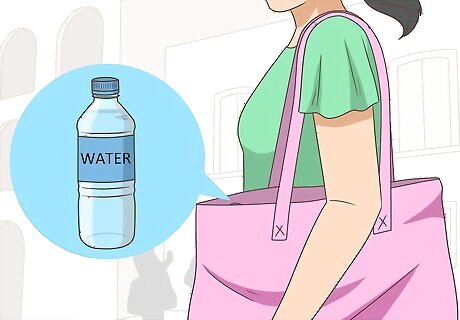
Carry a water bottle with you. Carrying a water bottle with you can help you stay hydrated even when you are far from a sink or fountain. Fill the bottle with water, a sports drink, or another fluid, and take it with you to work, school, and social events. It is a good practice to keep a bottle of water with you when you exercise or when you are going to be outside for long periods of time. Buy a reusable water bottle that you can wash between uses instead of a flimsy disposable bottle.
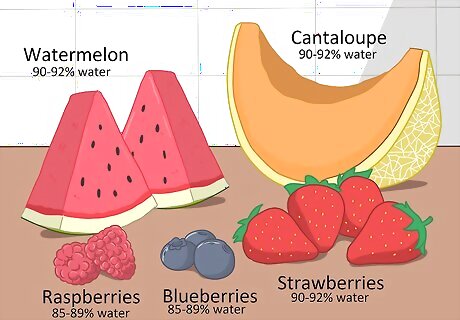
Delight in an array of fruits. Eating foods high in water content is a great way to assist in increasing your overall intake of fluids. Fruits are a great source of water. Watermelon, strawberries, grapefruit and cantaloupe are all between 90-92% water. Peaches, raspberries, pineapples, apricots and blueberries are each between 85-89% water. They can be eaten fresh, frozen or whipped up in the blender with some water or milk (perhaps some ice cream, too) to make smoothies. You can also throw several together and make a fruit salad.
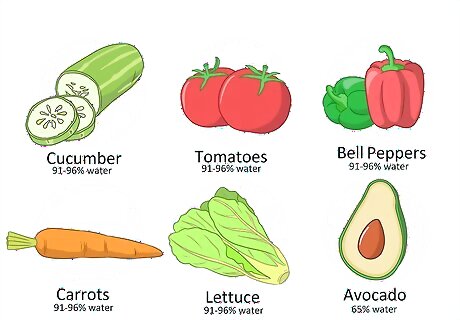
Slice into vegetables. Not only is munching on crispy cold vegetables a great way to stave off that thirsty feeling, a number of regularly used ones are also high in water. Cucumber, zucchini, tomatoes, radishes, bell peppers, carrots and lettuce are all between 91-96% water, with cucumber coming in first right behind lettuce. Avocado, a nutrient super food, is about 65% water. Eating these veggies alone fresh, as parts of other dishes or together as a salad is best because they lose a lot of water during the cooking process. With lettuce, eat the outer leaves within a day or two of buying it. Initially, lettuce contains more water in its outer leaves, but it stays longer in its internal leaves.
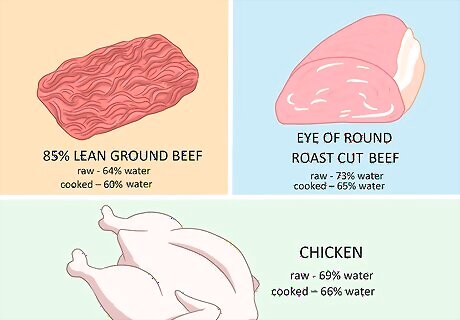
Bring on the meat. Who doesn’t love a nice big, juicy burger fresh off the grill on a summer afternoon? Ground beef that’s 85% lean is 64% water when raw and 60% when cooked. The “eye of round” roast cut of beef is 73% water when raw and 65% when cooked. The leaner the beef, the higher the water count. Chicken, a dieter’s delight, has a 69% water count before cooking and 66% afterward. Because water will seep out of chicken the longer it sits in the refrigerator, cook it as soon as possible after you buy it. When cooking meat or anything for that matter, make sure to limit your use of salt and spices to reduce your thirst. Both will make you thirsty. Spicy foods and foods containing a lot of salt, like ham, white bread, ketchup, chips, processed cheese and meat pizza, will naturally also increase thirst, too.
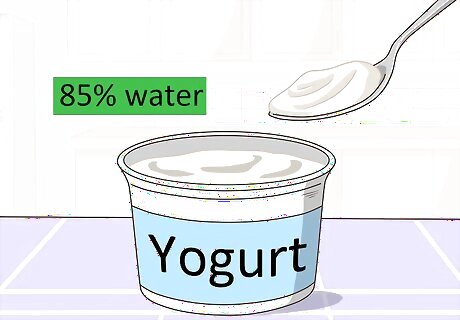
Dig into yogurt. One cup of yogurt is about 85% water. Once you factor in all the nutritional benefits, like its calcium and protein counts; the many flavor options; the low price; and how there’s no preparation involved, yogurt’s star shines brightly among food alternatives to fluids. Add some fruit to it, and you’re golden.
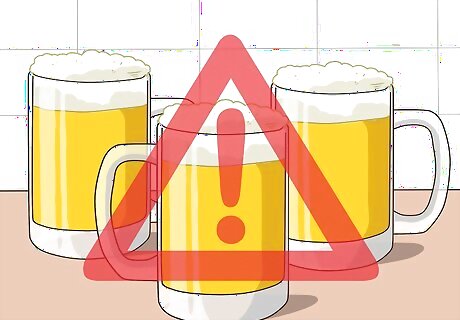
Avoid a lot of alcohol. Stay away from consuming large quantities of beer and wine, particularly. Contrary to popular belief, you’re not going to the bathroom a lot while drinking because you’ve added fluids – alcoholic drinks – to your body. Actually, it messes with your mind, literally. Alcohol reduces how much ADH, or anti-diuretic hormone, the pituitary gland in your brain produces. This causes you to urinate more, not just the alcohol, but also the fluids that were previously balanced in your body. Drinking more water won't help much either. Your body will only retain about 1/3 to 1/2 of the extra water you drink. Most of it will come out in your urine. It’s this process of dehydration that is the main cause of the dreaded hangover.
Quenching Your Thirst Without Drinking
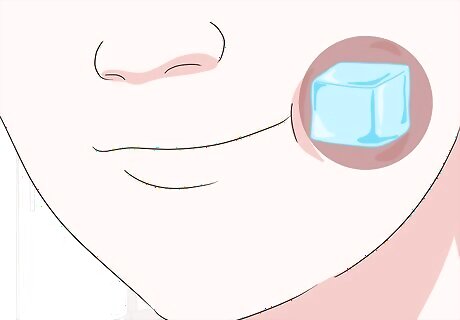
Suck on ice chips or ice cubes. There are times, such as when you can't eat or drink anything the night or morning before surgery, that you think you're starving – not for food but for just one sip of sparkling cold water. While this should be avoided before surgery, ice chips or ice cubes are the first things they give you when you wake up to help moisten your mouth and quench your thirst. So freeze some water in ice cube trays and put them in a cup or a plastic baggie (for ice chips, carefully break them into pieces) for immediate thirst relief.
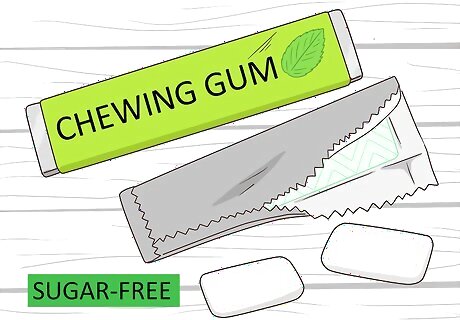
Chew sugar-free gum and suck on sugar-free hard candy. Chewing gum and sucking on hard candies will actually make your mouth produce more saliva, which in turn makes you less thirsty. While you also shouldn't do this before surgery, it's helpful if you are restricting liquids because of dialysis. It's also good for quenching thirst caused by any number of other things. Make sure you buy sugar-free hard candies that you not only enjoy but that also last a long time. The more you use, the more saliva your mouth will produce. Be warned, xylitol is often in sugar-free gum and sugar-free candies, and it can lead to diarrhea or cramps if enough is consumed. Sour candy cranks up your saliva glands, so if you can handle it give it a try, too. Chewing on whole mint leaves is cooling, refreshing and will also help quench your thirst.
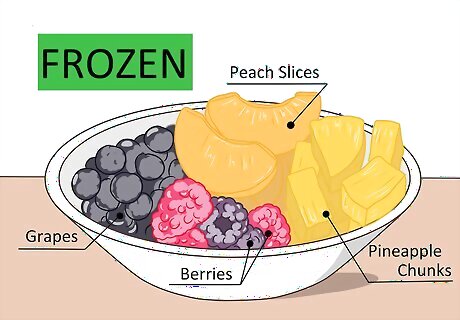
Suck on frozen fruit. At times, such as when a person is on dialysis, sucking on frozen fruits like grapes, peach slices and pineapple chunks, can be amazing thirst-quenchers. It helps because it, too, stimulates the production of saliva and has a high water content. Aside from grapes and other berries, all you need to do is cut them up and put them in a bag in the freezer. Or, for something like watermelon and cantaloupe, scoop out balls with an ice cream scooper before freezing. Lemon is another fruit you can also suck on frozen, or fresh if you like. It is one of the most effective fruits because its high level of citric acid really gets the saliva going.
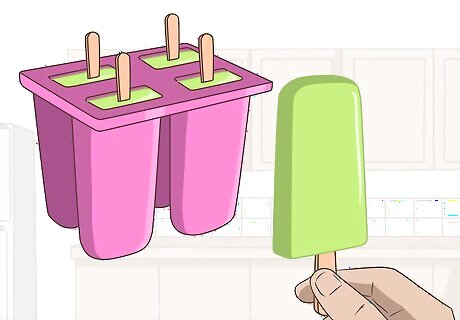
Make popsicles and flavored ice. This is another great general thirst quencher and one that is also useful during dialysis and after throat or mouth surgery (not before, for any surgery). Depending upon your diet, make tea or lemonade, or buy some apple juice or diet ginger ale. Pour it into popsicle molds or ice cube trays and freeze it. If you have sticks for the popsicles, wait to stick them in until they can stand up alone. If not, and for the flavored ice cubes, put your frozen goodies in a plastic baggie to hold and to catch what melts. You could also take the drinks and freeze them in plastic cups until they become thick slushies that you can scoop out with a spoon.
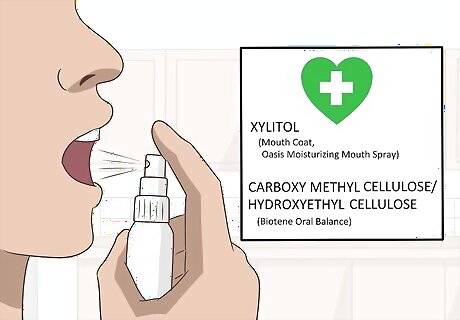
Head to the health aisles. Try over-the-counter saliva substitutes, especially those with products containing xylitol, such as Mouth Coat or Oasis Moisturizing Mouth Spray, or products with carboxy methyl cellulose or hydroxyethyl cellulose, such as Biotene Oral Balance. Again, too much xylitol can have unhappy effects, so take it slow. If you’re being treated for a health condition that is causing your thirst, talk to your doctor first before using these.
Regulating Your Body Temperature

Stay out of the heat. Maintaining a normal body temperature will also help a great deal in feeling less thirsty. The first step is staying out of the heat so you don’t become too hot. Overheating starts a chain reaction in which your internal AC unit kicks in to cool you, creating sweat. This causes you to lose body fluids and become thirsty. Because the sun is at its strongest between 10 a.m. and 3 p.m., try to rearrange your schedule so that you're not outside during these times, particularly during hot periods of the year. Run your errands in the early morning, for example. Have lunch delivered to your office rather than getting into your sweltering car twice – once on the way to lunch and again on your return. If staying out of the heat isn’t possible, try to limit the length of each outing as much as you can. Use buildings and trees to provide shade from the sun. And don’t forget that air conditioning was created for a purpose – to keep you cool.
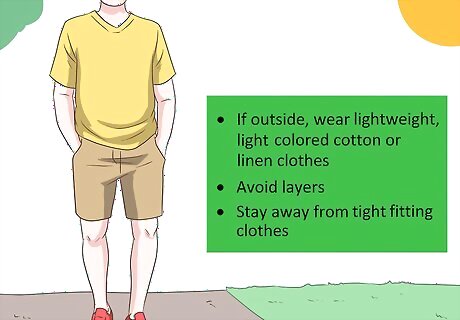
Wear appropriate clothing. Sometimes we simply can’t avoid being in the heat. Another way to make adjustments, however, is to choose clothes that will reduce the likelihood of becoming overheated. When it’s very hot out and you cannot avoid it, or when you know you’ll be in an environment that will make you sweat if not properly attired, pick your clothes wisely. If outside, wear lightweight, light-colored cotton or linen clothes. Light-colored clothes will reflect, rather than absorb, the sun’s rays. Cotton and linen are both fabrics that breathe, so they won’t trap heat like polyester, acrylic, nylon and rayon fabrics will. If you can avoid layers, definitely do so. They will only trap in heat to a greater extent, creating more sweat and less room for its escape. Stay away from tight-fitting clothes, too, unless they are specifically designed for breathability and to wick sweat.
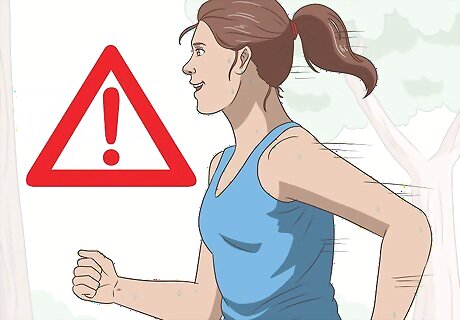
Avoid excessive exercise. Working out raises the risk of dehydration – if not adequately replenished – because your core body temperature rises, causing you to sweat and to lose body fluid. Controlling your body temperature, then, is critical, particularly if you do not or cannot adequately replenish the fluids lost. When you do exercise, a) wear only one layer of both lightweight and light-colored clothes when exercising outside and b) if your clothes become wet from sweat, change as soon as possible. And remember, a brisk walk on a hot and humid summer day can cause quite the sweat, too. When it’s humid, the moisture in the air stops sweat from evaporating from your skin, leaving you baking inside.
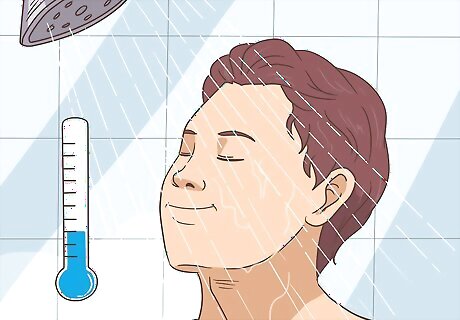
Cool down with water. If you’ve gotten too hot, one of the most effective ways of lowering your temperature is by taking a cool shower or bath. Make sure the water temperature is cool, not cold. It should be just below body temperature. If it’s too cold, when you get out your body responds by generating heat to warm up, which is not the effect you want. You can also try putting ice cubes in a thin towel and placing it for about two minutes at a time against your neck and on your wrist, two pulse points that you can reach conveniently throughout the day. This works because pulse points are areas in which blood vessels are close to the surface of the skin, therefore allowing for the transfer of cold through the body. Another option is to soak the base of your head and neck in cool water for 5-10 minutes. Here again, this area has a large concentration of blood vessels close to the skin’s surface and will help cool you down quickly.
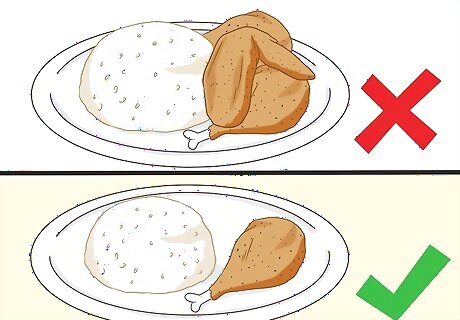
Don’t eat large meals. When you put food into your stomach, you get a boost of energy. Your metabolic system kicks in to digest the food and deliver the nutrients to other parts of your body. This process requires energy, which generates heat in your body – it’s called the Thermic Effect of Food (TEF). Large and heavy meals cause more energy to be created, making your internal temperature rise. So stick to eating smaller, more frequent meals.
Treating Dry Mouth
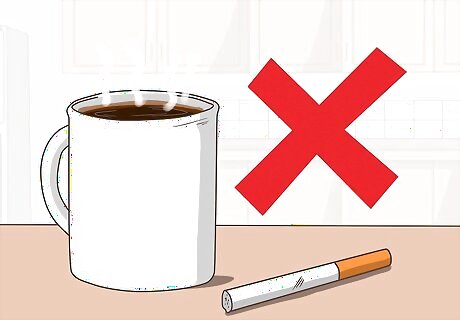
Cut out the coffee and cigarettes. Another reason people often feel thirsty is because they have dry mouth, a condition in which the mouth can’t produce enough saliva. This leaves the mouth not only dry but also irritated, sticky-feeling and craving fluids. If you are well hydrated and not overheated, you could have dry mouth. One means of reducing it is by ditching cigarettes and tobacco chew completely. It’s also wise to curtail your coffee intake. Both leave your mouth dry and you thirsty. If you’re a smoker and not ready to quit, try smoking less frequently, smoke only half of a cigarette at a time or wait longer between each puff – whatever it takes to decrease your overall intake.
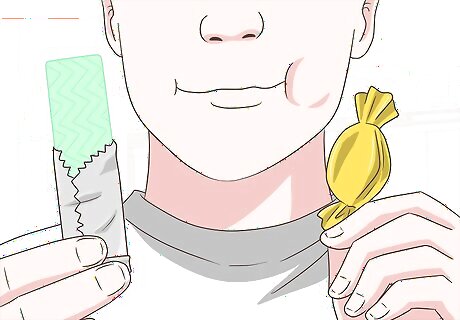
Chew gum and suck on candy instead. Just as chewing gum and candy helps in the immediate quenching of thirst, it also helps a great deal with persistent dry mouth. The more candy you suck and gum you chew, the more saliva you will produce. It’s best to find sugar-free hard candies and gums because poor oral health can also lead to dry mouth and, therefore, feeling thirsty.
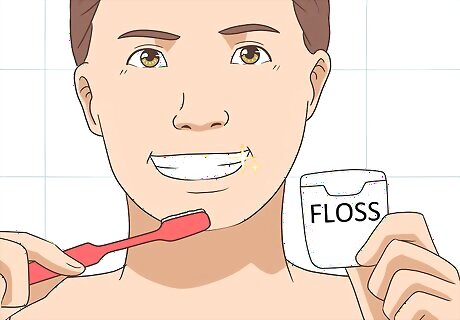
Take care of your teeth. Lots of bacteria grows in your mouth, so proper oral hygiene is a must. Brush and floss your teeth after every meal. Flossing is often overlooked, but it’s necessary it help get rid of the bacteria that not only decreases the production of saliva but also increases your chances of getting gingivitis, advanced gum disease and yeast infections, all of which can be caused by dry mouth and make it worse.. Visit the dentist regularly for exams and cleanings. Also have any necessary work done as soon as possible to correct existing problems contributing to or worsening your dry mouth.
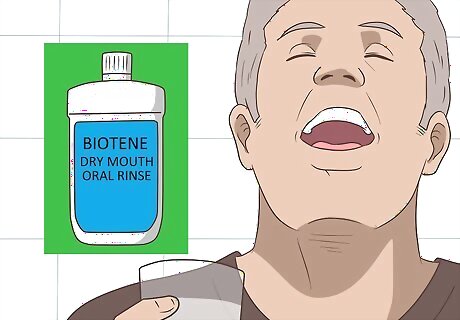
Try special mouthwashes. In addition to the saliva substitutes Mouth Kote, Oasis Moisturizing Mouth Spray and Biotene Oral Balance, use mouthwash specifically for dry mouth that has xylitol like Biotene Dry Mouth Oral Rinse or ACT Total Care Dry Mouth Rinse. On your way out, skip over the antihistamines and decongestants, which will only make it worse, and you more thirsty. While there, talk to the pharmacist about whether any medications you might be on cause excessive thirst or dry mouth. According to the National Institute of Dental and Craniofacial Research, over 400 medicines – from those for high blood pressure to those used for depression – can cause the salivary glands to produce less saliva.
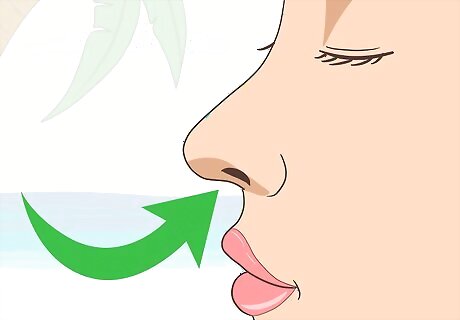
Breathe through your nose. When you breathe through your mouth, the air that passes through dries out your mouth. When your mouth is dry, you feel thirsty. Start noticing whether you breathe through your mouth or your nose; it’s not one of those things most people consciously pay attention to. Then make a concerted effort to do it and see if it helps!
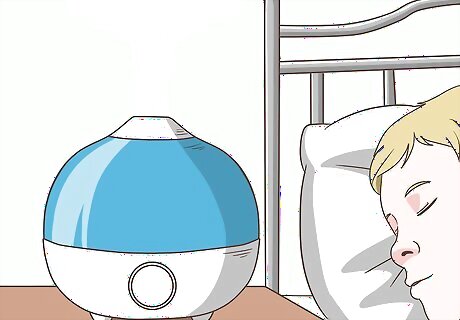
Use a humidifier at night. One of the first things most people reach for in the morning is a glass of water. Why? Because typically when we sleep, we breathe through our mouths, not our noses as instructed. Hours upon hours of doing this creates significant drying in our mouths. Using a humidifier, which adds moisture to the air, will reduce how dry your mouth becomes at night and help to alleviate what is sometimes called “cottonmouth.” Make sure you regularly clean the humidifier to avoid the growth of bacteria and mold.




















Comments
0 comment